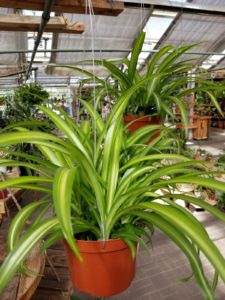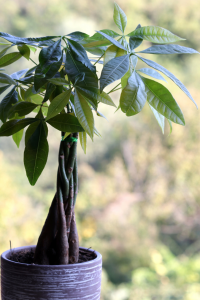 You have to love the nicknames that this week’s houseplant goes by: the airplane plant, the ribbon plant, and (our favorite) hen and chicks. But for most of us, the variegated leaves of Chlorophytum comosum are best known as “the spider plant.”
You have to love the nicknames that this week’s houseplant goes by: the airplane plant, the ribbon plant, and (our favorite) hen and chicks. But for most of us, the variegated leaves of Chlorophytum comosum are best known as “the spider plant.”
These are very easy plants to grow and very relatively forgiving of less-than-perfect care.
The slender leaves are striking on their own, but in time, your maturing plant will send out long stems from which little “plantlets” will develop. This is one of the reasons why these plants are so popular as hanging container plants. In fact, if you have them as on a shelf or a table, you’ll want to check periodically that the weight of those plantlets aren’t pulling the pot over.
You can easily propagate your spider plant with those plantlets. Once the plantlet develops roots that are at least an inch or two long, use a pruner to carefully cut it off the stem – keeping the roots intact – and plant in a new pot. Keep your new plant well watered (but not soggy) until the roots become more established.
Spider plants like indirect sunlight, as direct sunlight can burn the tips of their leaves. (Cut the tips off if this happens). They also like nice even moisture, so a good potting soil mix is essential. This is a tropical plant, so it truly loves heat and moisture, but will do well with average household temperatures and humidity – just keep it away from air conditioners and vents.
Spider plants grow fast, so you might want to repot them every once in a while so they don’t get root-bound.






 And that’s typically what you’ll see in nurseries – a plant that looks like its trunk is braided; it’s actually the five or sometimes even seven plants that are woven together to make one Money Tree.
And that’s typically what you’ll see in nurseries – a plant that looks like its trunk is braided; it’s actually the five or sometimes even seven plants that are woven together to make one Money Tree.

